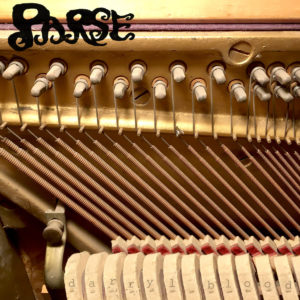 Darryl Blood – Parse
Darryl Blood – Parse
(2019, self-released)
Darryl Blood’s works are often based around piano motifs or chords (major, minor, 7th or augmented, jazz, and a kind of “dark jazz”) played straight on the beat, and this works perfectly as both rhythmic and harmonic bed on which to lay the listener. Many of Blood’s compositions are minimalist to a point—a jarring but welcome respite in these times of overproduction and packed arrangements—and, while some of his melodic sheets are content to stay close to that bed, others get up and wander around the room, while a few even stray into the hall and down the creaking stairs, going as far as the threshold of his aural haunted house before returning to that bed or evaporating altogether.
After numerous listens in various contexts and environments (how I wish I had my own haunted house in which to experience this album!), I still can’t decide if it’s a concept work. I’m a literal person and so words mean everything to me. Naming a collection of instrumentals “Parse” adds a level of mystery that feels at once both off-handed and coldly calculated. I’m driven to believe that Mr. Blood knows exactly what he’s doing when he applies a title—“The Staircase,” which I reviewed when it was included on Ball of Wax Volume 52 last May, evoked for me a nerve-wracked journey on the titular structure. The song is included here in an extended and even more frightening version, complete with sinister beat and low-in-the-mix voices and disembodied, breathy howls.
By now, one may have deduced that Blood’s works are united to some degree thematically. True, the man has scored a horror film. True, many of the track titles on “Parse” suggest elements of isolation (“Glass Ceiling,” “Excommunication”); danger (“Hear No Evil,” “The Staircase”); the supernatural (“Rain Song” and “The Angels,” both featuring unorthodox rhythmic accompaniment); and outright horror (“Killing Blow,” with its threat of subdued electronic mayhem)—but, where his score for horror film The Campus (recently retitled as “Deathday”) touched on, paid tribute to, and even inverted the sonic components of that genre, here the music speaks more on its own terms . . . which happen to bring along many of the ideas of that score and its genre but with more subtlety.
In particular, Blood brings in friend and cellist Gordon Withers, whose work here veers from the monochromatically atmospheric to shrilly discordant to melodically supportive. Blood has a strong collaborator in Withers: both share an ability (uncommon among musicians in my experience) to end a song without resolution, both are experimental in approach but still mindful enough to adhere to a song’s tonal center, and both have an understanding of how to devise an arrangement by subtraction as well as addition. It’s safe to say that the absence of Withers’s cello would alter these works significantly, safer still to say that “canned strings” (a.k.a. synth tones) could never bring the same timbre, resonance, and eerie warble with which Withers complements Blood’s compositions.
I initially attempted to interpret the album’s title as an instruction, but in so doing, began to fear I was losing the meaning of its songs as a greater whole. Blood and his other collaborators—John Hatziioannou (credited here as King Midnight) and Green Light Cameras mastermind Phil Chamberlin—add samples and sounds to “Parse” that defy musical analysis (Chamberlin takes the initial piano work on “Cluster” and drops it on the edge of a black hole soundworld, the singularity barely allowing anything audible to escape, which adds its own dread to a tune already detached from humanity) and the album is best taken as a complete piece. Remain wary of listening to it alone in a dark room, but do ensure that ambient sounds are minimized—you don’t want to miss a moment of sound or silence here.
